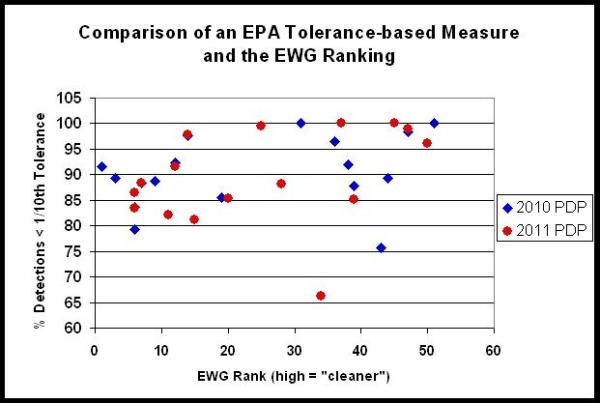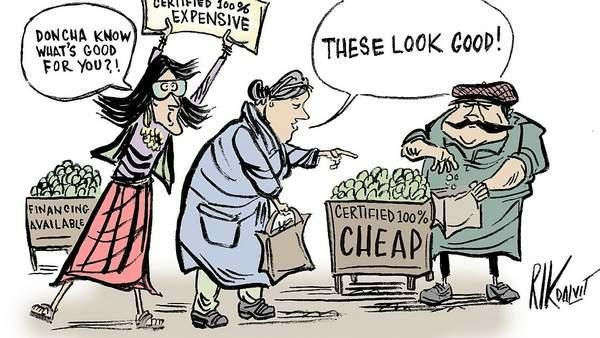
It's that time of the year when the Environmental Working Group produces its "Dirty Dozen List" - foods they believe you should fear the most.
That's bad news for farmers and certainly poor people in America. Because even if you score 99.9% on this test, you could still fail. That reason is because EWG creates a Bell Curve for food.
Each year, as part of the Pesticide Data Program, the USDA engages in random sampling of pesticide residues to confirm the safety of food, and each year the EWG takes their results and manipulates the findings to claim just the opposite. But for a lot longer than the USDA has been testing for pesticides, we have known that 'the dose makes the poison.' We're now in a world where we can detect parts per billion, so almost everything is detectable now, but it is at levels orders of magnitude below what could ever be dangerous. (1)
An example I have long used is shots of Scotch. If I told you a chemical in Scotch could cause you harm, you'd take that pretty seriously because we're the American Council on Science and Health, the one group you can be sure is separating health scares from health threats. But if I then told you that you'd need to drink 10,000 shots of Scotch all at once to get harm, you'd relax. You know that's actually impossible.
EWG leaves off that last part. Risk is hazard times exposure. Without thinking about exposure, and just using hazard, we get claims that apples are full of pesticides and that bacon causes cancer. EWG ignores the exposure part and declares hazard equal to risk. That leads to them creating a Bell Curve for food. In real terms, all food in America gets an A+ grade but on an EWG Bell Curve, apples are scary if the random samples show only 92% detections below 1/10th of tolerance.
It's miniscule.
This year the scary food is strawberries. Because their list is not scientific they always pick something they know kids eat. But ironically all those people who claim a Bell Curve is racist are most likely to ignore the fact that EWG is engaging in socioeconomic discrimination. The environmental group is convincing minorities and the poor that they should eat fewer fruits and vegetables unless they are sold by the organic corporations that donate money to EWG. And that takes too large a chunk of their food budget.
Organic food will never be at the top of a residue list simply because organic food ends up being a small proportion of random samples. Therefore, EWG feels vindicated in declaring that process superior even though they know their claim is fraudulent. However, in modern times there is one area where organic is high enough to be a meaningful part of samples: baby food. There is a lot of organic baby food because organic corporations tell new parents that organic food will help their child get into Yale (or whatever) and those parents use the precautionary principle and go with it (at least for the first child.) So organic baby food as part of random samples has been creeping up. On Science 2.0 a few years ago, Dr. Steve Savage showed that 11.5% of baby pear food samples were organic. Of the 67 samples, there were 101 pesticide residues detected. Even worse, only 33 of them were for an "organically approved" pesticide (Spinosad.) So not only did organic baby food have pesticide residues, most of them were not even organic pesticides.
Again, the baby food is safe. But it shows how EWG massages data to produce disinformation.
How can you know without me telling you? The USDA has a job to make the data publicly available, not to make it easy to use. The PDP samples generate around 2 million rows of information, which is a daunting Excel spreadsheet. Only about 1% of those will contain detectable residues. In the past, EWG has used that difficulty to their benefit, but now, thanks to more scientists fighting back against anti-science groups, their work gets peer reviewed after the fact. It's now commonly known EWG uses no recognizable scientific procedures of any kind in creating their list. And journalists can now go straight to the data and see the deception for themselves.
Given all that, it's obvious the Dirty Dozen List does a huge disservice to the public. If they cared about accuracy, they would tell you what scientists do - that the American-grown food supply gets an A+. Instead, they once again turn food into class warfare, contending that because organic food has different chemicals used on it, you will be healthier. This will discourage the public from partaking of the many health benefits of fruits and vegetables if they can't afford the organic process and the chemicals approved to get that sticker.
Though EWG claims otherwise, the take home message from science and health is the same again this year: eat fruits and vegetables. But don't eat 1,500 strawberries a day, because if you do you could approach a level of pesticides that could make you feel ill. If you can eat 1,500 strawberries a day, please film it for the folks at the Guinness Book of World Records.
Just eat healthy. How much you pay for the fruits and vegetables, and the process label on them, remain irrelevant. They're safe. The EWG war on America's poor can be called off until next year,
NOTE:
(1) Just try and go without chemicals:




